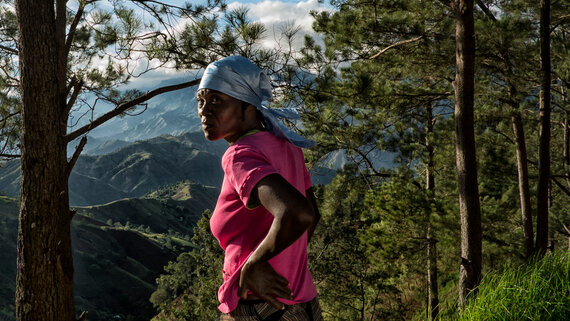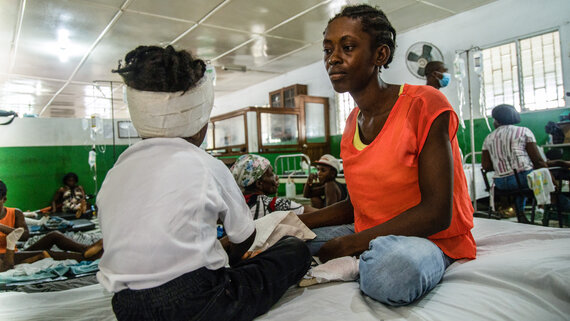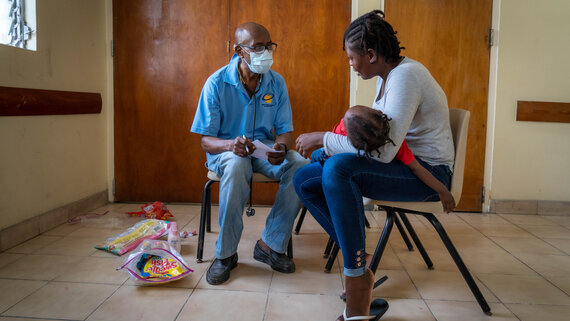Analysis of the context, crisis and needs
Regularly exposed to natural hazards and the effects of climate change, Haiti faces recurrent socioeconomic and political challenges that are anchored in deep-rooted structural problems. In 2021, the country experienced a profound and disturbing deterioration of the socioeconomic, political and security context. Compounded by the COVID-19 pandemic, and a 7.2-magnitude earthquake that affected more than 800,000 people on 14 August, humanitarian needs have exacerbated, especially in the country's southern region.
The activities of armed groups in the Port-au-Prince metropolitan area, which resulted in the displacement of more than 18,000 people, gained momentum with the assassination of President Jovenel Moïse on 7 July. This compromised humanitarian access particularly on the road to southern departments affected by the earthquake, roads which are under the control of armed groups and often the site of territorial fighting. In October, transport unions and the public protested and struck due to the growing insecurity. Armed groups (with political demands, among others) blocked access to roads leading to Port-au-Prince's oil terminals and significantly hampered fuel distributions. This severely impacted the functioning of health-care services, telecommunications, public transportation, bank services, and humanitarian and emergency relief operations. If this situation continues or is repeated, it could have serious consequences for the country, particularly regarding the humanitarian operations.

Port-au-Prince, Haiti
A woman stands in front of the mountains outside Port-au-Prince, Haiti.
UN/Logan AbassiThe worrying increase in kidnappings is adding to the sense of insecurity among the population and poses a growing threat to the protection of civilians and humanitarian workers. Insecurity and violence led to internal displacements and lack of safe and appropriate shelters, and increased the risk of gender-based violence (GBV) in a context where essential services are very limited and already stretched.
In addition, inflation, poor harvests due to below-normal rainfalls, Tropical Storms Elsa (July) and Grace (August), and the recent earthquake have all contributed to increased vulnerabilities throughout the country. In September 2021, around 4.3 million Haitians were acutely food insecure, 1.3 million of whom were in a situation of emergency (IPC4), with reports projecting this number to rise to 4.6 million in March 2022.
With more than 900 schools damaged or destroyed by the earthquake (and some used as emergency shelters), between 40 and 70 per cent of schools in the southern part of the country were unable to reopen for the new school year, while 300,000 children were expected to return to school. This is causing a delay in the school programme, a risk of dropout and withdrawal from school, and an increased risk of violence against children, including sexual exploitation and unwanted pregnancies.

Les Cayes, Haiti
Patients, families and medical staff in two hospitals in Les Cayes receive food and cash assistance. This mother was one of hundreds of people at the hospital, mostly mothers and children, crammed into a large room lined with mats after the paediatric ward was damaged in the August earthquake. Her four-year-old son’s head was wrapped in a bandage due to a deep wound, his eyes nearly swollen shut. She explained: “Our house was completely destroyed with my three children inside; one of my children is now in critical condition. We lost everything. He needs help, he needs medicine."
WFP/Marianela GonzalezThe low levels of access to safe drinking water have caused the transmission of diarrhoeal diseases while aggravating acute malnutrition. The low rate of vaccination against measles, hepatitis and polio (less than 80 per cent in 2021) exposes Haitians, particularly children under 5 years of age, to various diseases and contaminations. Access to health-care structures is a major concern. Damage to health facilities in the earthquake-affected areas further limits the population's access to health services, particularly emergency obstetric and neonatal care, in an already critical context for maternal health (Haiti's maternal mortality rate is 529 deaths per 100,000 live births, the highest in the region).
At the end of October 2021, Haiti had 23,406 confirmed COVID-19 cases and 658 deaths (as officially reported). Even though the number of infected persons remains relatively low compared to other countries, the pandemic poses a major risk to already weakened health structures. Despite a vaccination programme officially launched in mid-July, Haiti has the lowest vaccination rate against COVID-19 in the Americas (0.6 per cent).
In addition to this alarming situation, Haiti is facing a serious migration crisis. Between 19 September and 19 October 2021, IOM Haiti, in support of the National Office for Migrations, received and provided post-return assistance to more than 10,800 Haitian migrants (6,586 men, 2,456 women, 920 boys and 869 girls) repatriated from the United States, Mexico, Cuba, the Bahamas, and the Turks and Caicos Islands. This number adds to the 18,358 Haitian migrants who have been repatriated or expelled between the beginning of the year and mid-September mainly from the Dominican Republic, United States and Mexico, among other countries.
Projected situation in 2022 and beyond
In 2022, the humanitarian situation in Haiti will be influenced by developments in the country's socioeconomic, political and security situation, particularly the ongoing violence by armed groups and the elections expected to be held next year. The drivers that underpinned the vulnerability of the Haitian population in 2021 will persist in 2022, with more than 4.9 million people (43 per cent of the population) projected to be in need of humanitarian assistance.

Les Cayes, Haiti
The Gaskov Clergé Foundation provided mobile clinic services at the spontaneous IDP site at the église mormone in Les Cayes. The neighbourhood was badly affected by the August earthquake.
OCHA/Matteo MinasiInsecurity and violence are likely to persist in 2022, with potential consequences in terms of protection (including GBV), displacement, food insecurity, malnutrition and access to basic services. In addition, there are the climatic hazards and risks related to the natural threats that impact Haiti, as well as a projected 2022 active hurricane season, in conjunction with a stronger La Niña between July and October 2022.
While the entire country is exposed to multiple vulnerabilities, these will intensify in areas where there are overlapping crisis factors, such as in the South, Nippes and Grand'Anse departments affected by the earthquake, as well as the Port-au-Prince metropolitan area and regions with a high level of food insecurity.
Response priorities in 2022
In 2022, humanitarian partners will aim to target 2.5 million of the 4.9 million people in need of humanitarian assistance. The response will focus on three priority areas of intervention: (i) acute food insecurity, (ii) needs generated by insecurity and violence and (iii) residual needs following the earthquake. The latter focuses on the return to school, the provision of shelter for the most vulnerable people, the strengthening of health services and the restoration of livelihoods, while ensuring coordination with reconstruction activities and guaranteeing a transversal protection for affected people.
Haiti HRP
Humanitarian partners will strive to achieve the four strategic objectives that the Humanitarian Country Team has identified for the response over the period 2021-2022:
-
Reduce acute vulnerabilities and strengthen resilience through joint efforts of humanitarian and development actors, considering the structural nature of humanitarian needs in Haiti.
-
Increase people’s capacity to meet their basic needs through strengthening access to basic services, improving food security, and decreasing mortality and morbidity due to preventable diseases.
-
Enhance accountability to affected people, particularly to the most vulnerable groups, by strengthening their access to protection services, engaging them in all phases of the response and increasing their self-reliance.
-
Strengthen emergency preparedness and response to restore access to services and autonomy following a disaster, and to contribute to the empowerment of institutions and civil society.
Throughout the response, humanitarian actors will strive to integrate key cross-cutting approaches through dedicated cross-cutting groups (cash, accountability to affected people, access, prevention of sexual exploitation and abuse, and inclusion of persons with disabilities), which will play a leading role in the implementation of these strategic objectives. They will also commit to support the operationalization of the nexus in Haiti by coordinating their actions with development actors to operationalize public policies in relation to social protection, food security and food sovereignty, as well as in the framework of risk reduction linked to natural threats. Finally, partners will engage with national and departmental actors in preparedness and contingency for natural hazards and other scenarios related to the deteriorating situation in the country.
Further reading
Source: Humantiarian Insight
Source: Financial Tracking Service
Source: Office for the Coordination of Humanitarian Affairs



